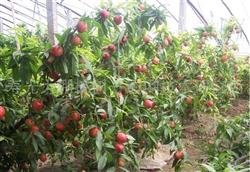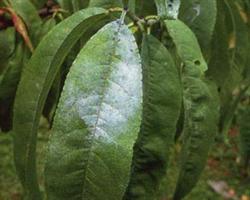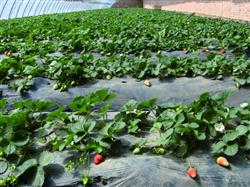Canopy nectarine management points through

The nectarine greenhouse should be built in a place with leeward facing sun, high dryness, good drainage and irrigation, fertile soil and sandy loam soil. It can be built in a 3-year-old peach forest, or you can choose a site to build a shed before transplanting, depending on the actual situation. When building the shed, the bamboo-wood structure is adopted, the one-sided slope greenhouse is built in the east-west direction, the back wall is built with hollow cement brick, the back of the shed is about 3 meters high, 50-100 meters long and 8.5 meters wide, the pillar is 4-5 rows, the column spacing is about 3 meters, the thick bamboo pole is used as the crossbeam, the shed film is made of polyethylene non-dripping film, and the rear wall leaves ventilation holes with a diameter of 30 cm every 10 meters or so. There is a 60 cm × 60 cm skylight every 8 meters at the top of the greenhouse, and a ventilation window is arranged at the front. At night, the greenhouse film is covered with more than 3 cm thick grass to keep warm. 1. Variety selection of nectarines planted in the greenhouse should choose early-maturing varieties, such as Zaohongzhu, May Fire and so on. 2. If the seedlings are transplanted in the peach forest, there is no need to transplant peach trees, as long as the fertilizer and water management can be strengthened. Before transplanting seedlings in the new greenhouse, the soil should be deeply turned over, and 4000-5000 kg of high-quality organic fertilizer, 20 kg of nitrogen, phosphorus and potassium compound fertilizer and 10 kg of potassium sulfate should be applied in each greenhouse. Dig 60 cm deep and 80 cm wide strip planting ditch. Seedlings with developed roots, strong seedlings, full buds and 3-year-old seedlings should be selected for planting seedlings. The planting should be in the north-south direction, the plant row spacing is 1.5m × 4m, and the ratio of main varieties to pollinated varieties is about 10 ∶ 1. During planting, the root system should be kept extended, watered after planting, and covered with plastic film. 3. The shaping of nectarine in plastic and pruning greenhouse generally adopts the population structure of north high and south low slope, the northernmost plant is 45-50 cm high, the tree shape is spindle shape, the tree shape is 1.5 meters high, the tree shape is happy shape, and the tree height is 1 meter high; the middle part increases gradually from south to north, and the two main branches of tree shape are "Y" shape. The pruning in front of the buckle shed is mainly thinning branches, leaving long branches, removing disease and insect branches, drooping branches, growing branches and strong vegetative branches without flowers, so as to maintain good light transmission conditions. 4. Fertilizer and water management one month before withholding the shed, 3000 kg of organic fertilizer, 25 kg of diammonium phosphate compound fertilizer and 10 kg of urea were applied to each shed and watered once. After watering, the hoe was paddled and covered with plastic film. In the young fruit stage, 0.3% urea solution was sprayed once; in the hard core stage, 0.3% potassium dihydrogen phosphate was sprayed in addition to 0.3% urea liquid. From the buckle shed to the falling flowers should not be watered, the humidity in the shed should be less than 60%, the hard core period and the fruit expansion period should be watered once, but the amount of water should be appropriate, not too large, so as to avoid the vigorous growth of new shoots and cause physiological fruit drop. 5. Temperature and humidity control gradually after holding the shed in mid-December. In the first stage, the grass grass was pulled to a height of 1 meter, so that only a small amount of light was penetrated into the shed, and the daytime temperature was kept at 8 ℃-13 ℃ for 7 days. In the second stage, the grass grass was pulled up at 1 ℃ 3-1 ℃, and the daytime temperature was kept at 10 ℃-16 ℃ for 7 days. After flowering, pull up all the grass, keep the temperature at 10 ℃-25%, and pay attention to the change of ground temperature. The daytime temperature is 18 ℃-24 ℃ and the night temperature is about 10 ℃. From anthesis to fruit ripening, the temperature is 22 ℃-28 ℃ during the day, the highest is not more than 30 ℃, the night is about 15 ℃, and the lowest is not less than 10 ℃. The humidity is maintained at 70% 80% before flowering, about 60% at flowering, and 50% at 60% after anthesis. In case of overcast, rainy or foggy weather, attention should be paid to the implementation of warming measures. 6. disease and pest control of nectarine in the greenhouse is mainly prevention and comprehensive control, with emphasis on peach perforation, peach aphid and mites. The disease can be controlled by stone-sulfur mixture, mancozeb, mancozeb, imidacloprid, aphid mites and other insecticides. 7. Management of flowering and fruiting period the management of nectarine flowering and fruiting stage in the greenhouse is a critical period, which is directly related to economic benefits. Therefore, only by strengthening the management of this period can we have a good harvest. Artificial pollination should be carried out at the flowering stage, too dense buds should be removed at the bud stage, one of the two flowers should be removed, and malformed flowers, late flowers, disease and insect flowers should be removed. The fruit began to be thinned 20 days after flowering, so that the fruit was evenly distributed. It is necessary to keep a single fruit on the short branch, double fruit on the middle fruit branch and 3-4 fruit on the long fruit branch. During the fruit coloring period, it is necessary to lift or support the drooping branches, keep the tree body ventilated and transparent, improve the light conditions of the tree body, and increase the fruit chromaticity. At the same time, the humidity in the shed should be strictly controlled to prevent fruit drop and fruit cracking caused by excessive humidity.
- Prev

Control of powdery mildew in peach trees
The prevention and control methods of peach powdery mildew are as follows: first, remove the diseased leaves after falling leaves and reduce the source of the disease. Second, spray chemical protection during the growing period: at the initial stage of the disease, spray 0.2 to 0.3 Baumetolite sulfur mixture, or 15% wettable powder trimethoprim 2000 to 3000 times, or 1500 to 2000 times methyl topiramate. Third, improve the ventilation and light transmission strip.
- Next

The reason why strawberry seedlings do not bear fruit
Strawberry only long stem, do not bear fruit, with the formation of flower buds have a more direct relationship, because strawberries only form flower buds, can blossom and bear fruit, if flower bud formation obstacles, it will lead to the phenomenon of no fruit. The factors affecting flower bud formation of strawberry were analyzed from internal factors and external factors.(1...
Related
- Moge, come on! The staff of the peasant association in the producing area of cantaloupe were frightened when the crowd gathered.
- Causes and Solutions of low Fruit setting rate of Apple
- Symptoms and control measures of passion fruit virus disease
- Fruit growing lesson: how do apple orchards keep high yields?
- Can you build orchards in the mountains? What are the pros and cons?
- How to manage the coloring period of Crisson grape?
- This paper introduces the processing technology of two kinds of fig products.
- How much is a month for retired teachers in rural areas by 2020?
- How can strawberry planting increase sugar content? We should pay attention to management in many aspects.
- What are the cultivation techniques on how to improve the yield of golden fruit?

